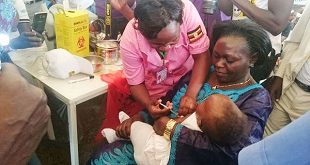
PAMAfrica consortium gets USD$50 million for new malaria therapies research
| Munyaradzi Makoni | Scientists racing to stop drug resistant malaria spreading globally are optimistic they can marry the molecules needed to find effective treatments. Malaria kills 400,000 people every year, according to the World Health Organization (WHO).
Although treatments, such as artemisinins, exist, they are effective only if given promptly. Scientists are anxious to stop drug-resistant strains from reaching Africa, which does not yet appear to have a problem with resistance and where 94 per cent of malaria deaths occurred in 2018. Children under five are most at risk, with the disease killing a child every two minutes, according to the WHO. For those in heavy malaria zones, such as the central African belt, children can be out of school for eight to 10 weeks of the year. Last week, PAMAfrica was granted more than US$50 million for new therapies research, by the European and Developing Countries Clinical Trials Partnership, non-profit Medicines for Malaria Venture (MMV), and pharmaceutical company Novartis.
The PAMAfrica research consortium will support the development of new treatments for malaria in the most-at-risk populations, including babies, patients with severe malaria, those with drug-resistant infections, and support the training of the next generation of leaders in clinical malaria research in Africa.
“There is a reason to be optimistic,” says Timothy Wells, chief scientific officer for MMV, which catalyses the development of new molecules and new medicines against malaria. “We are looking for medicines that are safe among children — the problem isn’t that they won’t work, but we need to ensure they will be safe enough to be used reliably, particularly among vulnerable populations.” This funding comes on the back of a new drive to get drug firms to collaborate to find a solution to the threat of antimalarial drug resistance.
Current treatments
In South-East Asia’s Mekong region, home to more than 300 million people, the malaria parasite is evolving quickly, resulting in the increasing risk of drug resistance. To prevent this resistance, two molecules must be combined in the treatment, the WHO requires.
Last year, Wells brought together drug developers to assess molecules in development that could be combined to create improved versions of the low-cost antimalarial drugs that have saved millions of lives in the past half a century. Artemisinin-based combination therapies have been found to be efficient in killing parasites in the body quickly, says Fred Binka, a clinical epidemiologist based at the University of Health and Allied Sciences in Ho, Ghana.
The drug takes 30 to 90 minutes to reach its peak and then disappears from the blood stream in four minutes, says Binka, once a coordinator of the WHO Emergency Response to Artemisinin Resistance in the Greater Mekong region.
“The beauty of those drugs is that parasites won’t have time to develop a mechanism to evade,” he tells SciDev.Net. “This is unlike chloroquine drugs that would take three to seven hours to reach their peak and will be eliminated in the blood at most in about 300 hours.”
Multiple suppliers are now providing artemisinin-based combination therapies – some of them flavoured so that small children do not reject them. But, even with artemisinin, new challenges are emerging.
The challenge of resistance
“Antimalarial resistance has not reached Africa yet, but we need to be prepared,” says Wells.
“Existing therapies are being used more widely and we’re developing new ones, which we hope will protect Africa from drug-resistant malaria from the Greater Mekong region.” Caroline Boulton, global programme head for malaria at Novartis, describes the process of finding new drugs.
“In practice, this requires screening of hundreds of thousands of potential drug candidates to identify a limited number which show activity against malaria parasites,” she says, adding that good drug development candidates are those which display strong kill rates against malaria parasites, and acceptable safety when used as monotherapy in humans.
“With few other companies working in the malaria field currently, we have very few potential partner compounds available,” Boulton adds. And this is the challenge that scientists face: every laboratory that develops a drug is looking for the most suitable partner for their drug, says Wells.
A ‘dating website’ for drugs
Wells set up the initiative to pair up drug companies in June, when he started the Malaria Drug Development Catalyst to find a solution to antimalarial resistance. “It’s like a dating website,” he says. The Catalyst has participants from three pharmaceutical companies: Zydus Cadila in India, Novartis in Switzerland, and Merck, headquartered in the United States. MMV tells each company the strengths and weaknesses of each molecule and shares this information with everybody involved. It summarises the potential of each partner then suggests that the groups with the best partnerships discuss collaborating. Questions the scientists ask include: “Do the drugs work together?” and “Does combining molecules improve or reduce the safety of the drug?”
“This works because there’s a peculiarity with malaria – we need a combination of drugs,” explains Wells. “Most of our partners don’t have two drugs or, if they do, they don’t work well together.”
The Malaria Drug Development Catalyst provides a framework for discussions about potential drug combinations and also allows some of the preliminary activities, such as preclinical studies, to assess whether particular combinations show promise to be conducted, says Boulton. “It would otherwise be difficult to bring different companies together to entertain these types of discussions,” she tells SciDev. Net.
Binka, who helped to develop WHO malaria treatment guidelines as a Technical Expert Group participant, and who is not involved with the initiative, says Africa needs the next generation of drugs: “We will prevent the loss of life and suffering, and boost economic activity.”
(This week’s THE INDEPENDENT #CoronaVirus Special Edition is online-only and available to all our readers. Read the other articles in the magazine here –click) 
*******
info@independent.co.ug
 The Independent Uganda: You get the Truth we Pay the Price
The Independent Uganda: You get the Truth we Pay the Price


